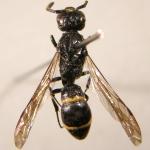Symmorphus bifasciatus misident.
See Symmorphus crassicornis for literature on this species.
From Dorset to Kent, and northwards to Oxfordshire and Lincolnshire. Recent records have come from Kent, Hampshire and Oxfordshire.
The species is listed as Rare (RDB3) in Shirt (1987) and Falk (1991).
From May until August, although most records are from July.
Larvae of the chrysomelid beetle Zeugophora subspinosa and the gracillariid moth Gracillaria stigmatella.
Principally as given under S. crassicornis. The nest of S. connexus has been found to consist of four cells, with females being reared from the two innermost cells, and males from the two outer cells. A space, or vestibule, is present between the brood cells and the plug of the burrow entrance to the nest. The prey is carried by just the mandibles, so that it hangs free (cf S. crassicornis).
Chrysis ignita has been associated with S. crassicornis in Europe.
1997


